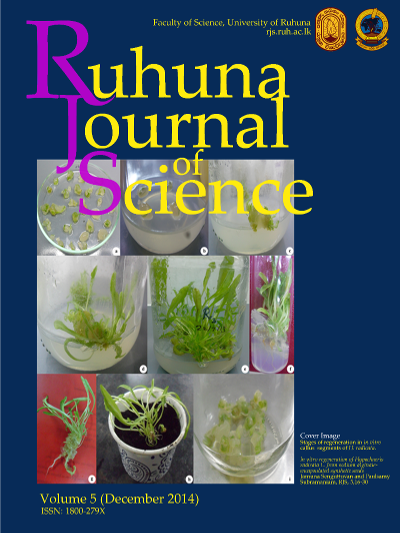Salient characters of Weedy rice (Oryza sativa f. spontanea) populations in highly infested areas in Sri Lanka
Abstract
Abstract. Weedy rice (WR) was first reported in 1990 and it is occurring with varying population densities in all agro-ecological zones in Sri Lanka. The identification of WR eco-types using agro-morphological characters which vary with time and remains as a major problem among the farmers and the agronomists. The WR population possesses a number of pleisomorphic (primitive) and apomorphic (derived) characters. This study focuses on identification of primitive and derived characters observed in WR. The identification of the salient trends of specialization of characters in WR populations facilitates the understanding of the rate diversification of WR populations. Seeds of presumed WR eco-types were collected from five different locations in Kurunegala and Matara districts. Five replicates with three plants of each eco-type were planted in plastic pots with representative paddy soils from each location. Replicates were arranged in Complete Randomized Design (CRD). Agro-morphological characterization (using thirty characters) of WR eco-types, wild rice and cultivated rice varieties were made using a Standard Characterization Catalogue. The collected data were separated into nominal and scalar variables and the nominal data were used to construct Classification and Regression Trees using CART algorithm. The long-fully awned and absence of awn were pleisomorphic characters and short-fully awned and long-partly awned characters were apomorphic in WR eco-type populations in Sri Lanka. These characters could be hypothesized as derived from mixing of germplasm either of cultivated or wild rice varieties indicating the possibilities of cross-pollination among wild, cultivated and weedy rice eco-types.Keywords. Agro-morphological, Oryza sativa f. spontanea, salient trends, Weedy rice.References
Abeysekara A. S. K., Nugaliyadda L., Herath H. M. S., Wickrame U. B. and Iqbal Y. B. (2010). Weedy Rice: a threat to direct seeded rice cultivation in Sri Lanka. Rice Congress 2010, PGRC, Gannoruwa. pp 17-18.
Breiman L., Friedman J., Olshen R., Stone C. (1984). Classification and Regression Trees. CRC Press, Boca Raton.
Ferrero A. and Finassi, A. (1995). Viability and soil distribution of red rice (Oryza sativa L. var. sylvatica) seeds. In Med. Fac. Landbouw., Rijksunv. Gent. pp. 205-211.
Hoagland R.E. and Paul R.V. (1978). A comparative SEM study of red rice and several commercial rice (Oryza sativa) varieties. Weed Science 26:619-625.
Khush G. S. (1997). Origin, dispersal, cultivation and variation of rice. Plant Molecular Biology 35: 25-34.
PGRC (Plant Genetic Resources Centre) (1999). Characterization Catalogue of Rice (Oryza sativa) Department of Agriculture., Ministry of Agriculture and Lands, Sri Lanka.
Qinjin C., Bao R. L., Hui X., Jun R., Francesco S., Alberto S. and Fabbrizio G. (2006). Genetic diversity and origin of weedy rice (Oryza sativa f. spontanea) populations found in North-eastern China revealed by Simple Sequence Repeat (SSR) makers. Annals of Botany 98: 1241-1252.
Downloads
Published
Issue
Section
License
From Volume 7 (2016) onwards, all articles published in Ruhuna Journal of Science are Open Access articles published under the Creative Commons CC BY-NC 4.0 International License. This License permits use, distribution and reproduction in any medium, provided the original work is properly cited and is not used for commercial purposes.
Copyright on any research article published in RJS is retained by the respective author(s).
Authors who publish with this journal agree to the following terms:
a) Authors retain copyright and grant the journal right of first publication with the work simultaneously licensed under a Creative Commons Attribution License CC-BY-NC 4.0 International, that allows others to share the work with an acknowledgement of the work's authorship and initial publication in this journal.
b) Authors are able to enter into separate, additional contractual arrangements for the non-exclusive distribution of the journal's published version of the work (e.g., post it to an institutional repository or publish it in a book), with an acknowledgement of its initial publication in this journal.
c) Authors are permitted and encouraged to post their work online (e.g., in institutional repositories or on their website) prior to and during the submission process, as it can lead to productive exchanges, as well as earlier and greater citation of published work (See The Effect of Open Access).

